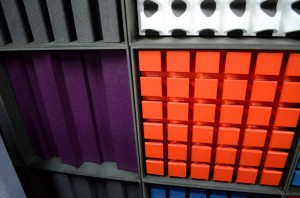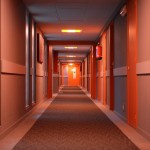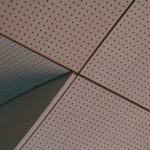16
Mar
2015
Acoustic Treatment Basics – Types And Forms Of Acoustic Treatment

Reading Time: 4 minutes
Architectural acoustic treatments for beginners!
Written by: Jordan Chia
There is a key difference between acoustic treatment and soundproofing – acoustic treatment aims to make a room optimal for the benefit of a given application, rather than preventing sound from escaping (check article about soundproofing by clicking here). In this post, we will discuss what options are available to achieve great acoustic treatments.
Room Size, Dimensions and Shape
Velocity based absorbers are useful acoustic treatments for tackling general problems, including compensating for less than ideal room modes, and controlling the reverb time for a room.
Room dimensions have a significant impact when it comes to acoustic treatment. Sound waves can bounce of walls and add on to the direct sound, leading to early reflections, flutter echo, and reverberation. The larger the room, the bigger their effects. How much of it we want added to our direct sound really depends on the application. Is it going to be a concert hall for classical music? Are we recording instruments here so that they can be suitable for studio work? These applications have different demands and require the appropriate type of acoustic treatment. It is evident that acoustic treatment is as much a science as it is an art. In the Boston Symphony Hall, large statues (probably put in there for other reasons) on the side, among other things, contributed to ideal acoustics for classical performance. Sound waves also have varying wavelengths, and if the physical distance between 2 solid walls match the wavelength of a given frequency, a phenomenon known as the standing wave (also known as resonance or room mode) occurs when the wave bounces between the 2 walls. It is similar to pushing a person on a swing with just the right rhythm – doing so will give rise to the maximum swing. This is not good for critical listening as it artificially boosts the amplitude of that associated frequency. Critical listening becomes inaccurate and recorded instruments become colored. This phenomenon affects surfaces along the length, width and height of the room. Such resonances are called axial modes. In addition, sound can bounce of the walls more than once, leading to more complex resonances such as tangential and oblique modes. This is a heavy subject, so we will leave it to future posts. Most of us do not have specialized software to deal with this, so this are some useful values known as bolt ratios which help us when designing room dimensions. They are as follows:
1 : 1.14 : 1.39
1 : 1.28 : 1.54
1 : 1.60 : 2.33
Note that these values can be used in any order whether it is length, width or height. These ratios are by no means the final say on what perfect room ratios and relative acoustic treatments should be – they simply give us a general guideline based on what has worked over the years in real world situations. Parallel walls also lead to standing waves, so in professional recording situations, it is best to keep the walls at a certain angle to reduce this phenomenon.
Sound Absorption
Obviously, room dimensions have to be determined at the building stage of a space. Many times, room dimensions of an existing space do not fall in ideal ratios and it is rare to find a general purpose room with non-parallel walls. To combat this problem, we can use a variety of methods – the first of which is through sound absorption via wall panels, ceiling panels, etc. This form of acoustic treatment can be classified into 2 categories – velocity based absorbers and pressure based absorbers. Each have their own strengths and weaknesses.
Velocity Based Absorbers

Any acoustic treatment in the form of panel or bass trap that uses porous material belongs to this category. Materials can range from fibreglass, rockwool, foam, etc. They attenuate sound energy by converting and releasing it as heat energy. They can reduce sound energy throughout most of the frequency range, although thicker panels can absorb lower frequencies. Since they cover a large frequency range, they are also known as broadband absorbers. Velocity based absorbers are useful acoustic treatments for tackling general problems, including compensating for less than ideal room modes, and controlling the reverb time for a room.
Pressure Based Absorbers
This type of acoustic treatments occupy less space than velocity based absorbers and are mainly used to address low frequency problems. Sealed panel absorbers, Helmholtz resonators, membrane absorbers fall into this category. These are narrow band absorbers and used for targeting a specific frequency. They become ineffective if a wide frequency range needs to be addressed and if not designed well, they can resonate at an unwanted frequency.
Miscellaneous Materials
Chances are, the room has furniture, carpets, sofa, windows and many other things that can affect the sound. Even having more people in the room has an effect on acoustic treatments. Objects absorb sound in varying amounts at particular frequencies. Speaker placement is also critical. There are areas in a room which can cause the reflected sound of a wall to cause phase cancellation with what is being heard in the speaker (also known as Speaker Boundary Interference). Finding the right place for speaker placement should be a priority – based on the geometry of the room. Once the best place is found then can we use some of the tools mentioned to address the problems that remain. All factors must be taken into account or used to our advantage.
Putting the Tools Together
The level of complexity in acoustic treatment truly depends on the budget and application. For a critical listening environment, reverb time should be precisely calculated and the correct absorbers should be used to address offending room modes. This can be difficult and require technical expertise as well as experience, since sometimes the real world results do not match the numbers. One mistake that arises often is the overzealous placement of acoustic panels and bass traps. When too many foam absorption panels are used, the bass frequency becomes relatively louder and makes it even harder to address uneven frequency response. An overly dead room is also bad for recording instruments where room acoustics play a big part in give its color – guitars, violins and drums.
Conclusion
As you can see, acoustic treatment must be targeted to a specific application. There is no one room that is good for all purposes. The complexity involved can be staggering. On this note, future articles we will explore acoustic treatment in specific applications.
If you want to read more about sound design and acoustics follow us on Twitter.





